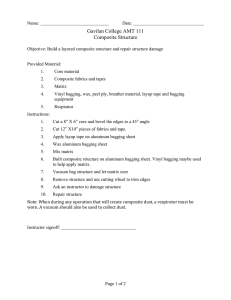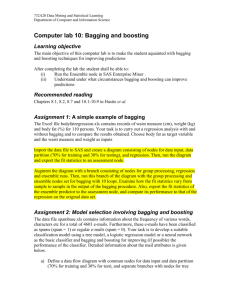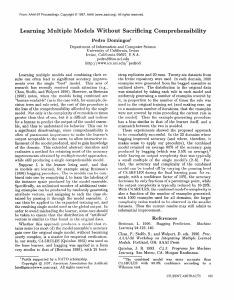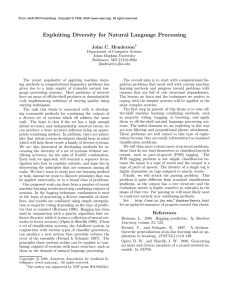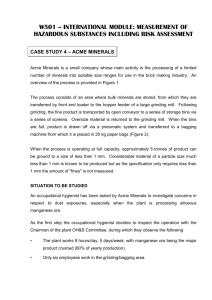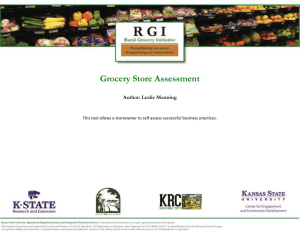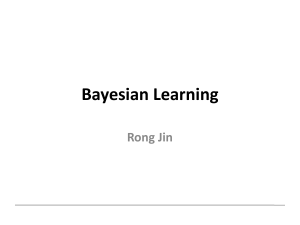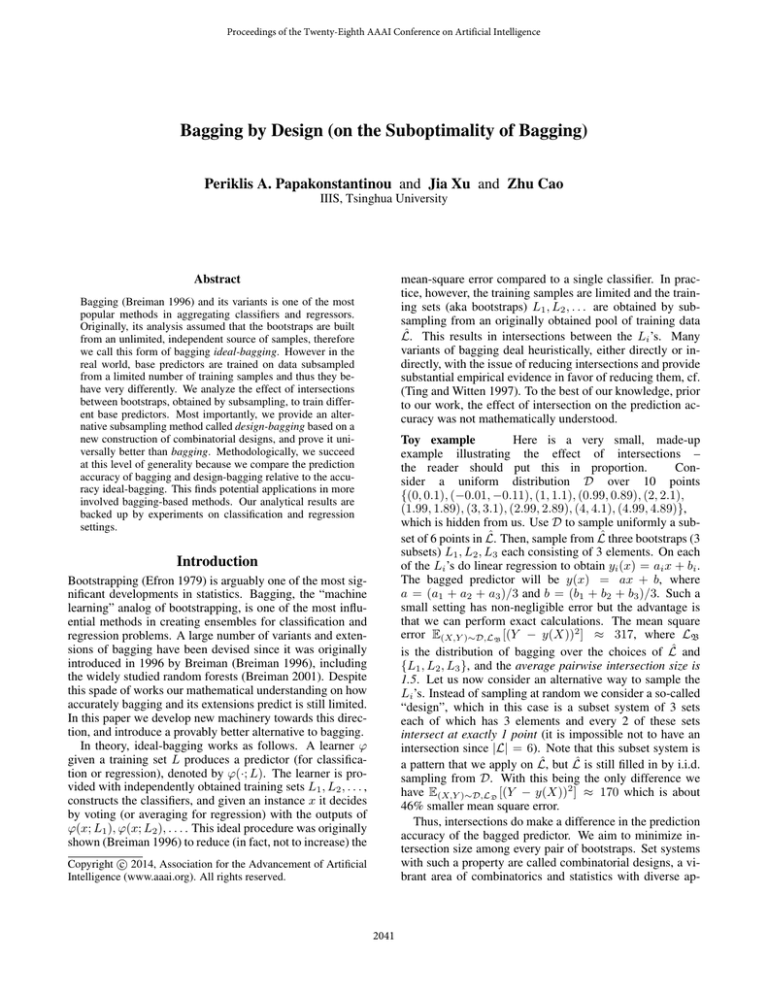
Proceedings of the Twenty-Eighth AAAI Conference on Artificial Intelligence
Bagging by Design (on the Suboptimality of Bagging)
Periklis A. Papakonstantinou and Jia Xu and Zhu Cao
IIIS, Tsinghua University
Abstract
mean-square error compared to a single classifier. In practice, however, the training samples are limited and the training sets (aka bootstraps) L1 , L2 , . . . are obtained by subsampling from an originally obtained pool of training data
L̂. This results in intersections between the Li ’s. Many
variants of bagging deal heuristically, either directly or indirectly, with the issue of reducing intersections and provide
substantial empirical evidence in favor of reducing them, cf.
(Ting and Witten 1997). To the best of our knowledge, prior
to our work, the effect of intersection on the prediction accuracy was not mathematically understood.
Bagging (Breiman 1996) and its variants is one of the most
popular methods in aggregating classifiers and regressors.
Originally, its analysis assumed that the bootstraps are built
from an unlimited, independent source of samples, therefore
we call this form of bagging ideal-bagging. However in the
real world, base predictors are trained on data subsampled
from a limited number of training samples and thus they behave very differently. We analyze the effect of intersections
between bootstraps, obtained by subsampling, to train different base predictors. Most importantly, we provide an alternative subsampling method called design-bagging based on a
new construction of combinatorial designs, and prove it universally better than bagging. Methodologically, we succeed
at this level of generality because we compare the prediction
accuracy of bagging and design-bagging relative to the accuracy ideal-bagging. This finds potential applications in more
involved bagging-based methods. Our analytical results are
backed up by experiments on classification and regression
settings.
Toy example
Here is a very small, made-up
example illustrating the effect of intersections –
the reader should put this in proportion.
Consider a uniform distribution D over 10 points
{(0, 0.1), ( 0.01, 0.11), (1, 1.1), (0.99, 0.89), (2, 2.1),
(1.99, 1.89), (3, 3.1), (2.99, 2.89), (4, 4.1), (4.99, 4.89)},
which is hidden from us. Use D to sample uniformly a subset of 6 points in L̂. Then, sample from L̂ three bootstraps (3
subsets) L1 , L2 , L3 each consisting of 3 elements. On each
of the Li ’s do linear regression to obtain yi (x) = ai x + bi .
The bagged predictor will be y(x) = ax + b, where
a = (a1 + a2 + a3 )/3 and b = (b1 + b2 + b3 )/3. Such a
small setting has non-negligible error but the advantage is
that we can perform exact calculations. The mean square
error E(X,Y )⇠D,LB [(Y
y(X))2 ] ⇡ 317, where LB
is the distribution of bagging over the choices of L̂ and
{L1 , L2 , L3 }, and the average pairwise intersection size is
1.5. Let us now consider an alternative way to sample the
Li ’s. Instead of sampling at random we consider a so-called
“design”, which in this case is a subset system of 3 sets
each of which has 3 elements and every 2 of these sets
intersect at exactly 1 point (it is impossible not to have an
intersection since |L| = 6). Note that this subset system is
a pattern that we apply on L̂, but L̂ is still filled in by i.i.d.
sampling from D. With this being the only difference we
have E(X,Y )⇠D,LD [(Y
y(X))2 ] ⇡ 170 which is about
46% smaller mean square error.
Thus, intersections do make a difference in the prediction
accuracy of the bagged predictor. We aim to minimize intersection size among every pair of bootstraps. Set systems
with such a property are called combinatorial designs, a vibrant area of combinatorics and statistics with diverse ap-
Introduction
Bootstrapping (Efron 1979) is arguably one of the most significant developments in statistics. Bagging, the “machine
learning” analog of bootstrapping, is one of the most influential methods in creating ensembles for classification and
regression problems. A large number of variants and extensions of bagging have been devised since it was originally
introduced in 1996 by Breiman (Breiman 1996), including
the widely studied random forests (Breiman 2001). Despite
this spade of works our mathematical understanding on how
accurately bagging and its extensions predict is still limited.
In this paper we develop new machinery towards this direction, and introduce a provably better alternative to bagging.
In theory, ideal-bagging works as follows. A learner '
given a training set L produces a predictor (for classification or regression), denoted by '(·; L). The learner is provided with independently obtained training sets L1 , L2 , . . . ,
constructs the classifiers, and given an instance x it decides
by voting (or averaging for regression) with the outputs of
'(x; L1 ), '(x; L2 ), . . . . This ideal procedure was originally
shown (Breiman 1996) to reduce (in fact, not to increase) the
Copyright c 2014, Association for the Advancement of Artificial
Intelligence (www.aaai.org). All rights reserved.
2041
plications, cf. (Colbourn and Dinitz 2010). Known designs
have much smaller size and much bigger number of blocks.
Thus, they are not suitable for our purposes – our design is
reminiscent to weak designs (Hartman and Raz 2003) for
which we circumvent the lower bound using much less sets
and relaxed intersection size.
We ask how much and what kind of theory can be developed for bagging and its extensions. Despite the wealth
of successful empirical studies and heuristics, analytically
much less has been done.
First, studies of more statistical nature (Bühlmann and Yu
2002; Friedman and Hall 2007) addressed the issue of prediction accuracy using assumptions about the predictors, and
analyzing things at places either heuristically or asymptotically. For example, in (Bühlmann and Yu 2002) there are
three explicit assumptions and some implicit assumptions,
in places the analysis turns to the analysis of continuous
analogs of Brownian motion, and at the end experiments are
used to indicate rates of convergence. For the application to
machine learning it is desirable to have only minimal statistical assumptions, and moreover we care about actual rates
of convergence and not that much for asymptotics.
In more practical settings for bagging and more importantly for its extensions, such as random forests, it is surprising that the current state-of-the-art deals with arguments
about the consistency of the aggregated predictors as outlined in (Biau, Devroye, and Lugosi 2008; Biau, Cérou,
and Guyader 2010; Denil, Matheson, and de Freitas 2013).
Thus, in addition to previous important works there is still
much room in understanding bagging and its relatives.
In the realm of theory of machine learning boosting and
in particular Adaboost (Freund and Schapire 1997) is shown
to boost the accuracy of a weak classifier with PAC guarantees (Valiant 1984) to a strong classifier which also has
PAC guarantees. Can bagging boost the performance of
a weak learner in the PAC sense? Following the work of
(Long and Servedio 2013) we show, for certain parameters,
that nothing similar to Adaboost can be proved for bagging
due to its inherent parallelism (this can be obtained easily as a corollary of Theorem 18 of their paper). In other
words, in the PAC sense bagging, together with every parallel ensemble method, cannot achieve boosting. On the
other hand it is not clear what PAC guarantees mean for
the real-world bagging – e.g. in (Bauer and Kohavi 1999;
1999) there are certain settings where bagging appears to be
more accurate than boosting. All these suggest that bagging
in the real world should be theoretically studied further.
In this paper we take a novel, but modest first step in analyzing bagging-like algorithms by comparing them to its
ideal analog (ideal-bagging) under very minimal assumptions. We feel that this is an appropriate level for developing
a practically relevant theory. We analyze the effect of intersections assuming two properties that the base classifiers enjoy, and we show our design-based-bagging better than bagging independently each case. For us “better” means closer
to the behavior of ideal-bagging. This is probably all we can
hope at this level of generality. Our analysis is for regression
settings and binary classification, but this is only for simplicity of exposition (it extends to multi-label classification).
Here is an informal statement of our first theorem.
Theorem 1 (informal statement). If bagging is more stable
to noise than a single predictor then design-bagging outperforms bagging.
This is a perhaps surprising statement which assuming a
good property for bagging we conclude that design-bagging
is even better! We make precise what do we mean by
tolerance to noise later on. For now we note that idealbagging unconditionally enjoys this noise-stability property.
Note that the effectiveness of bagging to deal with noise has
been verified before as in e.g. (Friedman and Hall 2007;
Dietterich 2000; Bauer and Kohavi 1999; Melville et al.
2004). In this sense noise-stability is a very mild assumption for bagging.
Our second main theorem assumes that the base predictors enjoy the following property. If we independently
train two predictors using two bootstraps L1 , L2 then on
(most) input instance(s) x the covariance of their outputs
EL1 ,L2 ['(x; L1 )'(x, L2 )] increases the more L1 and L2 intersect. Again this is a very believable property.
Theorem 2 (informal statement). If for the base classifiers
the covariance EL1 ,L2 ['(x; L1 )'(x, L2 ) |L1 \ L2 | = k]
increases as a function of k, then design-bagging outperforms bagging.
By minimizing the covariance of pairs of predictors we
increase the “diversity” of the base predictors. The issue
of diversity in ensemble learning is a very well studied
one cf. (Kuncheva and Whitaker 2003; Dietterich 2000;
Tang, Suganthan, and Yao 2006), but it is not clear which notion of diversity is the right one (Tang, Suganthan, and Yao
2006). In our case though, this simple covariance (which
accounts for “linear” correlations) is conclusive and mathematically sound. Our experiments show that more intersection on the bootstraps yields more covariance, and by only
assuming this we analyze our design-bagging.
Besides these two main theorems we also obtain statements showing that design-bagging makes decisions which
are well concentrated (not only in the mean square-loss
sense), and we also bound its distance from ideal-bagging.
This is regardless of any additional statistical dependencies
among the classifiers. This concentration is on the rate of
convergence and not in some asymptotic sense.
Notation and terminology
By design we refer to a collection of sets S =
{L1 , . . . , Lm }, each Li is also called a block and |Li | = b,
where most pairs Li , Lj i 6= j do not intersect much (to
be quantified in context). D commonly denotes distribution over instances X. The pool of samples from which
we obtain the bootstraps is denoted by L̂, |L̂| = N . A
single learning algorithm ' : X ⇥ L ! Y trains base
models '(·; L1 ), . . . , '(·; Lm ), where Li ✓ L̂, |Li | = b,
and we write L for the collection of the Li ’s. Technically,
our study is for su-bagging, which is shown the same (but
cleaner to analyze) as bagging (Bühlmann and Yu 2002) –
all our statements carry through for bagging adding an extra
conditioning. Three distributions are of interest: (i) LI for
2042
ideal-bagging where the Li ’s are chosen i.i.d from D; (ii)
LB for bagging where the probability space is induced by
first sampling L i.i.d. and then subsampling from it the Li ’s
each independently from the set of all subsets of L of size b;
(iii) LD for design-bagging we choose a filter over L (this
choice can also be probabilistic) which consists of the relative positions of the L1 , L2 , . . . inside L̂ and subsequently
fill in i.i.d the elements of L̂ which also results the Li ’s. We
write 'I , 'B , 'D for the learners which aggregate by voting (or averaging for regression) for ideal-bagging, bagging,
and design-bagging respectively. The generalization error
of the learner is measured by the mean square error (MSE)
– though our main results are stronger, they hold with high
probability – where S('I ) = ELI (y 'D (x))2 , S('B ) =
ED,LB (y 'B (x))2 and S('D ) = ED,LD (y 'D (x))2 .
Proof. We count the sum of intersection sizes instead of average (same for a fixed number of blocks). We sum over all
elements on the number of times each of them is P
covered
by distinct blocks (much simpler to interchange the ’s this
way). Denote the times that element i has been covered be
ri , 1 i N . Then, since each element is in the intersection if it belongs to a block pair, the total intersection is
N
P
P
ri
ri = bm. It is easy to see that the sum of
2 , where
i=1
intersections achieves the minimum when the ri ’s are equal,
which is indeed achieved by our new algorithm (if N does
not divide bm let maxi ri = mini ri + 1). Therefore, in
this algorithm, the total intersection is 2r ⇥ N and thus the
(r)⇥N
average intersection size is 2 m .
(2)
The approximate design and its properties
Corollary 1 (Design vs Random sampling). Denote the
average intersection size of design-bagging by µB and that
of bagging by µD , then µD < µB and furthermore µD
bm N
bm b µB .
The bulk of this paper are the theorems of the next section.
Part of their lengthy proof is constructing an approximate
design and obtaining relevant guarantees. We present our
efficient approximate design here first, which can be of independent interest.
Blocks Generating Algorithm outperforms baggingderived subsets Lemma 2 is the most involved technical
part – its proof is in the full version online. We show that the
curve of the cumulative distribution (CDF) of the block intersection size k, FD (k; n, m, b) resulted-in by BGA strictly
dominates FB (k; n, m, b), the CDF of the original bagging.
FD is defined for an arbitrary pair of blocks, which is welldefined since BGA treats blocks symmetrically.
Efficient Approximate Design
Algorithm 1 Blocks Generating Algorithm (BGA)
Input: block size b, number of blocks m, universe size N
Initialize m empty blocks.
for i = 1 to b ⇥ m do
choose L at random from the set of blocks with current
min # of elements
S : set of elements in the universe not in L that appear
least frequently
L
L[{e}, where e 2 S chosen uniformly at random
end for
Output: m blocks each with b distinct elements.
Lemma 2. Let FD (k; N, m, b) and be FB (k; N, m, b) the
cumulative distribution functions as above. Then for all k
where FD (k; N, m, b) < 1 it holds that FD (k; N, m, b) >
FB (k; N, m, b).
This algorithm has a great advantage over choosing L’s
}
randomly from {1,...,N
, especially when m ⇥ b cN
b
for c ⇡ 5, . . . , 20. In particular, Algorithm 1 (i) achieves
minimum average intersection size (Lemma 1) and (ii) it
concentrates the distribution around this expectation. This
(Lemma 2) is the main technical part of this paper; in particular, known Chernoff-Hoeffding or other concentration
bounds are weaker than what our arguments ask for.
Figure 1: blue curve: PDF
of the execution of our
randomized algorithm for
N = 500, m = 20, b =
125, red curve: random
sampling.
Blocks Generating Algorithm is optimal on the average
Every greedy algorithm that iteratively minimizes the intersection size (e.g. BGA), has optimal average intersection
size; i.e. the expected arithmetic mean of the |Li \ Lj |’s
for every i < j. This simple fact is Lemma 1, and note that
the probabilistic decisions made by BGA are not relevant for
this lemma.
Lemma 1 (Average intersection size optimality). Among
all constructions of m blocks, each of size b, from a universe
of N elements, Algorithm 1 achieves minimum average in(r)⇥N
tersection size with value 2 m , where r = mb/N .
(2)
Figure 2: CDF for the
same experiment. (mathematically shown in Corollary 1, Lemma 2).
A corollary of the above lemma is that for ideal-bagging,
and for distributions over D’s with sufficiently large support
we obtain the following.
FD (k; N, m, b),
and
Corollary 2. Let FI (k),
FB (k; N, m, b) be the cumulative distribution functions of
the intersection sizes of ideal-bagging, design-bagging, and
bagging. Then, for all k where FD (k; N, m, b) < 1 holds
FI (k; m, b) > FD (k; N, m, b) > FB (k; N, m, b)
2043
Covariance-biased Chebyshev Sampling
Noise-stability for Bagging =)
Design-Bagging is even better
Although the outputs of the predictors (classifiers or regressors) are otherwise arbitrarily correlated the following polynomial rate of convergence can be shown. This is used later
on in the analysis and comparison of design-bagging.
The previous developments enable us to compare designbagging and bagging. We first deduce this assuming bagging slightly noise stable (see Introduction for references on
empirical evidence). We define the noise ⌘ generally as the
statistical distance induced on the output of the classifiers
aggregating with and without noise.
Definition 1. (Approximate Pairwise Independence) An ensemble of variables {Xi }i2I is said to be ↵-pairwise independent if for each pair i 6= j of variables Xi and Xj ,
E[Xi ]E[Xj ]
Assumption 1 (noise stability). Given ', there is ⇢ 2
(0, 1], such that for every x and noise ⌘, if |Var['(x, D)]
Var['(x, D + ⌘)]| ✏, then |Var['B (x, D)]
Var['B (x, D + ⌘)]| m✏⇢ .
↵ E[Xi Xj ] E[Xi ]E[Xj ] + ↵
We call ↵ the covariance parameter of {Xi }i2I .
The following simple theorem can be also of independent
interest.
We remark that the requirement about all x’s can be replaced by “most x’s” (in fact, just for Theorem 1 if the
assumption holds for the expected x would be sufficient).
This assumption is not to be confused with the fact that bagging works better when the base classifier is unstable, which
means (EL ['(x, L)])2 is far away from EL ['(x, L)2 ]. Finally, we remark that ideal-bagging unconditionally satisfies
it and moreover with the strongest ⇢ = 1.
Theorem 3 (cov-biased Chebychev Sampling). For ↵pairwise independent variables X1 , . . . , Xn and k > 0
P
⇣ n ⌘2
X
X
Var[Xi ]
Xi E[
Xi ]| k] i 2
+↵
P[|
k
k
i
i
Proof. Recall that Chebyshev’s inequality states for random
variable X with finite expectation µ and finite variance
and any positive real number k, P(|X µ| k ) k12 .
P
X
X
Var[ i Xi ]
P[|
Xi E[
Xi ]| k]
k2
i
i
P
P
E[( i Xi E[ i Xi ])2 ]
=
k2 P
P
E[Xi ]E[Xj ])
i Var[Xi ] + 2
i<j (E[Xi Xj ]
=
2
k
P
Var[Xi ] + n(n 1)↵
i
k2
Proposition 1. For ideal-bagging, if |Var['(x, D)]
Var['(x, D + ⌘)]| ✏, then |Var['I (x, D)]
✏
Var['I (x, D + ⌘)]| m
.
Now, we are ready to restate Theorem 1 formally.
Theorem 1 (formally stated). Suppose that Assumption 1
holds for a base learner '. If S('B ) S('I )
, then there
is < 1, such that S('D ) S('I ) (S('B ) S('I )).
Furthermore, ( ) is a decreasing function of .
Proof outline: Here is a high-level sketch of the proof
of this theorem. The argument relies on the fact that typically there is huge statistical distance between ideal-bagging
and bagging, and that the distance from ideal-bagging to
design-bagging is smaller. The details are somewhat technical but the high-level idea is simple (see full version for
the details). We proceed using a probabilistic hybrid argument. Intuitively, we can visualize a point in a metric
space (each point is a distribution) which corresponds to
ideal-bagging, and another point which corresponds to bagging. The argument shows that we can move (“slowly reducing distance/interpolating”) between these two points and on
this specific path we will meet the point that corresponds to
design-bagging. Formally, we proceed by introducing the
notion of pointwise noise stable CDF graph, which is then
formally related to Assumption 1. Then, we invoke Lemma
2 to show that if both ideal-bagging and bagging enjoy this
property then design-bagging is also point-wise noise stable
and in some sense between the two.
Better than bagging
The presentation of our proofs is modular; i.e. the statements
of the previous section are used in the proofs here.
The goodness of Design-Bagging
Fix any bagging-like aggregation method (e.g. bagging or
design-bagging) and consider the covariance parameter ↵ of
any two predictors. Theorem 3 suggests that significantly
bounded covariance parameter ↵ for specific classifiers (e.g.
k-NN, SVM) yields very strong concentration guarantees in
the rates of convergence. If we do not care about so precise
performance guarantees, e.g. if we only care about the MSE
then things become straightforward. In particular, if ↵ is an
upper bound on the covariance parameter in the outputs of
any two predictors for some bagging-like method then
More intersection yields more correlation =)
Design-Bagging better than Bagging
Consider the situation where we independently train base
predictor on two bootstraps L1 , L2 . For these two predictors
and any input instance x we denote the correlation of their
def
outputs by g(k; x) = EL1 ,L2 ['(x; L1 )'(x, L2 ) |L1 \ L2 | =
k]. Then, it is plausible to assume that
MSE of this aggregation method S('I ) + ↵
The above follows immediately by expanding the MSE for
this aggregation method. In the full version we compute the
parameter ↵ for certain restricted cases of classifiers.
2044
Covariance between each two single
predictors trained on these bootstraps respectively
Assumption 2 (correlation). For all input instances x,
g(k; x) is an increasing function of k.
Again, the requirement “for all” can be relaxed to “for
most”. Our empirical results overwhelmingly show that natural classifiers and regressors satisfy this property. This assumption is necessary since there exist (unrealistic) learners
where the covariance oscillates with the intersection size.
Counter-example Here is an example of a constant classifier which works as follows: ignore any label assigned to
the input instance (just the value of the instance matters)
and consider the parity of the numerical sum of the integer instances. This parity determines the output of the constant classifier. Consider {1, 2, 3, 4, 5, 6}, and subsets of
size 3 with distinct elements ai , aj , ak . If ai + aj + ak
is odd we let the yz (x) = 1 where z is the subset, else
yz (x) = 0. Below z1 , z2 denote two subsets of size 3.
Then, |z1 \ z2 | = 0
=)
E[yz1 (x)yz2 (x)] = 0,
|z1 \ z2 | = 1 =) E[yz1 (x)yz2 (x)] = 3/10, |z1 \ z2 | =
2 =) E[yz1 (x)yz2 (x)] = 2/10, |z1 \ z2 | = 3 =)
E[yz1 (x)yz2 (x)] = 1/2, and so on.
2
=y +
'(x, Li )
i
{z
2y
P
i
500
FB (k; N, m, b))
m
X
E'2 (x, Li )
Assumption verification
i
FD (k
In the main part we prove that under the covariance assumption design-bagging outperforms bagging (Theorem 2). We
will analyze the correlation of classification and regression
outputs on both real data set MNIST and data sets from
the UCI repository, as well as on simulated data generated
by adding multivariable low and medium energy Gaussian
noise around hyperplanes in Rn .
For MNIST, we uniformly at random choose 100 from
the test data and 1000 from the training data considering
100 features. Figure 3 shows the correlation between the
intersection portion of each two bootstraps in average and
the covariance of each two single predictors trained on these
1; N, m, b) g(k; x)
k
FD (k; N, m, b) g(k; x)
g(k + 1; x)) < 0
We provide empirical evidence (i) supporting the covariance
assumption and (ii) comparing bagging to design-bagging in
classification and regression settings. Our study is on various base learners and data sets from the UCI repository and
on a real data set MNIST. In the full version we significantly
expand this experimental section including: (i) more realworld datasets (not limited to the UCI repository), (ii) experimental results for MNIST (not only for the assumption
verification), (iii) statistical significance tests if necessary,
and (iv) in a later version (but not the current full version)
we may include extensions to random forests.
We focus on (*), since S('B ) and S('D ) differ only there.
By conditioning and decomposing the expectations:
X
100
150
200
250
300
350
400
450
Number of Intersection samples between each two bootstraps for bootstrap size 500
Empirical results
(⇤)
=
50
This discussion is for regression. Something similar holds
for classification (see full version).
E'(x, Li )
m
We deliberately did not subscript the expectation E'(x, Li )
to emphasize that although the underlying distribution is indeed LD this is not important — this is the expectation over
a single isolated predictor and it is the same for any sampling method that uses a training set of size b chosen i.i.d.
from D. Now, let us expand on the underbraced part:
!2
m
X
X
E LD
'(x, Li )
=2
ELD ['(x, Li )'(x, Lj )]
|
{z
}
i
i<j
ELD ['(x, Li )'(x, Lj )]
X
=
FD (k; N, m, b)
0
where the inequality is by Lemma 2 and Assumption 2.
!2
}
+
0.7
0.65
(g(k; x)
!2
m
1 X
'(x, Li )
m i
1
ED,LD
m2
|
0.8
0.75
k
Proof. First, let us expand S('D ):
m
X
0.9
0.85
S('D ) S('B ) =
m 1X
(FD (k; N, m, b)
m
S('D ) < S('B )
y
SVM
KNN
Figure 3: The mean covariance between single predictors
trained on each bootstrap pair is a function of the intersection portion between these two bootstraps. The x-axis
denotes the intersection size of two bootstraps (each 500
elements large). The y-axis denotes the mean covariance
between two predictor outputs trained on these two bootstraps. This classification task is performed on the real
dataset MNIST with single predictors trained using k-NN
and SVM.
Theorem 2 (formally stated). If Assumption 2 holds then
S('D ) = ED,LD
1
0.95
g(k + 1; x)
k
with the last equality being a very handy observation. Doing
the same for S('B ):
2045
Covariance between results of single predictors
trained on these two samples respectively
1
SVM
C4.5
KNN
0.9
0.8
0.7
0.6
0.5
0.4
0
10
20
30
40
50
60
70
Percentage of intersection part between each two bootstraps
80
90
100
Figure 4: The mean covariance of the outputs of two predictors trained on a bootstrap pair as a function of the intersection portion between these two bootstraps. The x-axis
denotes the percentage of the intersection of the two bootstraps. The y-axis denotes the mean covariance between the
predictor outputs trained on these two bootstraps. This classification task is performed on an artificial dataset of a mixture of Gaussian distributed samples with single predictors
trained using C4.5, k-NN and SVM.
Data set
Fisher’s Iris
Wine
Ionosphere
Wine Quality (MSE)
Base
70.67
92.50
87.91
0.6386
Bagging
73.33
94.81
90.24
0.4075
Design
74.00
95.37
91.00
0.4048
Figure 5: The mean covariance of the outputs of two predictors trained on a bootstrap pair as a function of the intersection portion between these two bootstraps. The x-axis
denotes the percentage of the intersection part of two bootstraps. The y-axis denotes the difference of the covariance
with the covariance at x=0 (0.2709 for linear regression and
0.2574 for non-linear regression); The covariance is measured between single predictor outputs trained on these two
bootstraps. This regression task is performed on an artificial set of Gaussian noise added around hyperplane with single predictors trained using linear regression and low-degree
polynomial regression.
Algorithm
SVM
C4.5
C4.5
CART
bined based on voting, and we set the number of samples
in each bootstrap to N/2 (cf. (Bühlmann and Yu 2002;
Friedman and Hall 2007) justifying this choice), where N
is the number of training samples. To reduce the effect of
outliers we run the same experiments 30 times and the results in average are shown in Table 1.
On Fisher’s Iris data, we applied a 10-fold crossvalidation to evaluate a binary classification task, whether
the class is the species ’versicolor’. We used the SVM in
Matlab to train the single classifier. On the data set of
Wine, Wine Quality and Ionosphere, we applied Decision
Tree C4.5 to train the single classifier. The test set is 10%
of the whole data set uniform randomly selected and the rest
samples are taken as the training set for each task. Table 1
shows a consistent improvement in the classification accuracy and regression squared error rate using bootstraps selected with design bagging than that selected with the bagging of (Breiman 1996) and that of a single base predictor.
Table 1: Classification accuracy[%] and regression squared
error rate using single base predictor, bagging (Breiman
1996) and design-bagging on different data set.
bootstraps respectively. We repeated the same experiment
1000 times for all classification tasks to remove the random
noise. As we can see, from Figure 4, the functions for algorithm SVM and k nearest neighbors, i.e. k-NN (k = 3) are
close to monotone increasing functions. In fact, the more
repetition of experiments we perform, the function tends to
be more strictly monotone.1 Figure 4 and Figure 5 also indicates that this function is close to a monotone increasing one
on a set of uniform randomly generated Gaussian distributed
samples. To reduce sporadic effects, we repeated the same
experiment 1000 times for all classification tasks and linear
regression. For polynomial regression we repeated for 450K
times.
Recognition results
Conclusions and future work
We applied two algorithms (SVM and decision tree C4.5) to
evaluate the recognition and regression performance boosted
by the design bagging we introduced. Four well-known data
sets are used Iris, Ionosphre (converted) for binary classification tasks, Wine as a multi-class (3 classes) classification
task, and the Wine Quality as a regression task. The details of the data sets can be obtained from the UCI repository: number of samples, features as well as classes can
be found in the full version. Bagging and design bagging are performed on 30 bootstraps (m = 30) and com-
This work is in its biggest part theoretical. Under two very
general properties of classifiers we prove that bagging is not
the optimal solution, where optimal refers to ideal-bagging.
Implicit to our work is the idea that instead of proving directly that a certain ensemble method works, it removes
complication and unnatural assumptions to compare with its
ideal counterparts. One question we did not touch is what
is the optimal bagging-like aggregation method. Finally, besides the foundational issues, we believe that our approach
can find further applications in ensemble methods for which
bagging is a building block. This latter part necessarily will
involve large-scale experimentation.
1
Theoretically, measure concentration (as derived by an immediate calculation on the Chernoff bound) shows up later on ⇡0.5M
iterations/sample.
2046
Acknowledgements
Tang, E. K.; Suganthan, P. N.; and Yao, X. 2006. An analysis
of diversity measures. Machine Learning 65(1):247–271.
Ting, K. M., and Witten, I. H. 1997. Stacking bagged and
dagged models. In ICML, 367–375.
Valiant, L. G. 1984. A theory of the learnable. Communications of the ACM 27(11):1134–1142.
We are most grateful to the anonymous reviewers who
pointed a number of typos and inaccuracies and whose remarks significantly improved this paper and its full version.
This work was supported in part by the National Basic Research Program of China Grant 2011CBA00300,
2011CBA00301, the National Natural Science Foundation
of China Grant 61033001, 61361136003, 61350110536.
References
Bauer, E., and Kohavi, R. 1999. An empirical comparison
of voting classification algorithms: Bagging, boosting, and
variants. Machine learning 36(1-2):105–139.
Biau, G.; Cérou, F.; and Guyader, A. 2010. On the rate of
convergence of the bagged nearest neighbor estimate. The
Journal of Machine Learning Research 11:687–712.
Biau, G.; Devroye, L.; and Lugosi, G. 2008. Consistency of
random forests and other averaging classifiers. The Journal
of Machine Learning Research 9:2015–2033.
Breiman, L. 1996. Bagging predictors. Machine learning
24(2):123–140.
Breiman, L. 2001. Random forests. Machine learning
45(1):5–32.
Bühlmann, P., and Yu, B. 2002. Analyzing bagging. The
Annals of Statistics 30(4):927–961.
Colbourn, C. J., and Dinitz, J. H. 2010. Handbook of combinatorial designs. CRC press.
Denil, M.; Matheson, D.; and de Freitas, N. 2013. Narrowing the gap: Random forests in theory and in practice. arXiv
preprint arXiv:1310.1415.
Dietterich, T. G. 2000. An experimental comparison of
three methods for constructing ensembles of decision trees:
Bagging, boosting, and randomization. Machine learning
40(2):139–157.
Efron, B. 1979. Bootstrap methods: another look at the
jackknife. The annals of Statistics 1–26.
Freund, Y., and Schapire, R. E. 1997. A decisiontheoretic generalization of on-line learning and an application to boosting. Journal of Computer and System Sciences
55(1):119–139.
Friedman, J. H., and Hall, P. 2007. On bagging and nonlinear estimation. Journal of statistical planning and inference
137(3):669–683.
Hartman, T., and Raz, R. 2003. On the distribution of the
number of roots of polynomials and explicit weak designs.
Random Structures & Algorithms 23(3):235–263.
Kuncheva, L. I., and Whitaker, C. J. 2003. Measures of
diversity in classifier ensembles and their relationship with
the ensemble accuracy. Machine learning 51(2):181–207.
Long, P., and Servedio, R. 2013. Algorithms and hardness
results for parallel large margin learning. Journal of Machine Learning Research 14:3073–3096. (also NIPS’11).
Melville, P.; Shah, N.; Mihalkova, L.; and Mooney, R. J.
2004. Experiments on ensembles with missing and noisy
data. In Multiple Classifier Systems. Springer. 293–302.
2047

